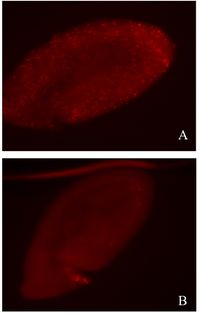User talk:Jmartin9520
Introduction
At right is a sample image insertion. It works for any image uploaded anywhere to MicrobeWiki. The insertion code consists of:
Double brackets: [[
Filename: PHIL_1181_lores.jpg
Thumbnail status: |thumb|
Pixel size: |300px|
Placement on page: |right|
Legend/credit: Electron micrograph of the Ebola Zaire virus. This was the first photo ever taken of the virus, on 10/13/1976. By Dr. F.A. Murphy, now at U.C. Davis, then at the CDC.
Closed double brackets: ]]
Other examples:
Bold
Italic
Subscript: H2O
Superscript: Fe3+
General Information
Include some current research in each topic, with at least one figure showing data.
Male-killing Pathway
How and when Spiroplasma poulsonii selectively kills male Drosophila flies is a key part of understanding their host-pathogen relationship. Several papers have been published trying to uncover the specific pathway of male-killing that the bacterium causes. The dosage compensation complex (DCC) and programmed cell death, apoptosis, are two important portions that may be involved in the pathway.
Dosage Compensation Complex
Drosophila males differ from females by their number of X chromosomes; males have a single X while females have a pair. This genetic discrepancy is balanced through the hypertranscription of the male X chromosome by the dosage compensation complex. In females, a protein called Sex-lethal (SXL) inhibits the production of DCC components, preventing unnecessary dosage compensation. Male flies do not express the proper form of Sxl, and SXL cannot affect DCC components. Four proteins in the DCC have been tested using loss-of-function mutations. Mutant fly lines with these DCC components reduced or absent showed a reduction in male-specific lethality. This demonstrates that the DCC must be functional for Spiroplasma to successfully target and kill developing male flies. (Veneti et al., 2005)
Apoptosis
The other potential mechanism that causes male embryonic death is an increased number of male embryonic cells undergoing apoptosis, resulting in overall organism death. It has been found that male D. melanogaster embryos infected with the bacterium development slowed between stage 10 and stage 13 in embryogenesis and completely arrested in stage 13 about 10 hours after egg laying. Before stage 13, male embryos showed an increased amount of apoptotic cell death as compared to females. Apoptosis in uninfected individuals begins naturally at stage 10, the stage at which infected male embryos begin to die, suggesting that apoptosis is affected by the Spiroplasma bacterium. (Bentley et al., 2007)

Population Dynamics
Include some current research in each topic, with at least one figure showing data.
Conclusion
Overall paper length should be 3,000 words, with at least 3 figures.
References
Edited by Jennifer Martin, a student of Nora Sullivan in BIOL187S (Microbial Life) in The Keck Science Department of the Claremont Colleges Spring 2013.

